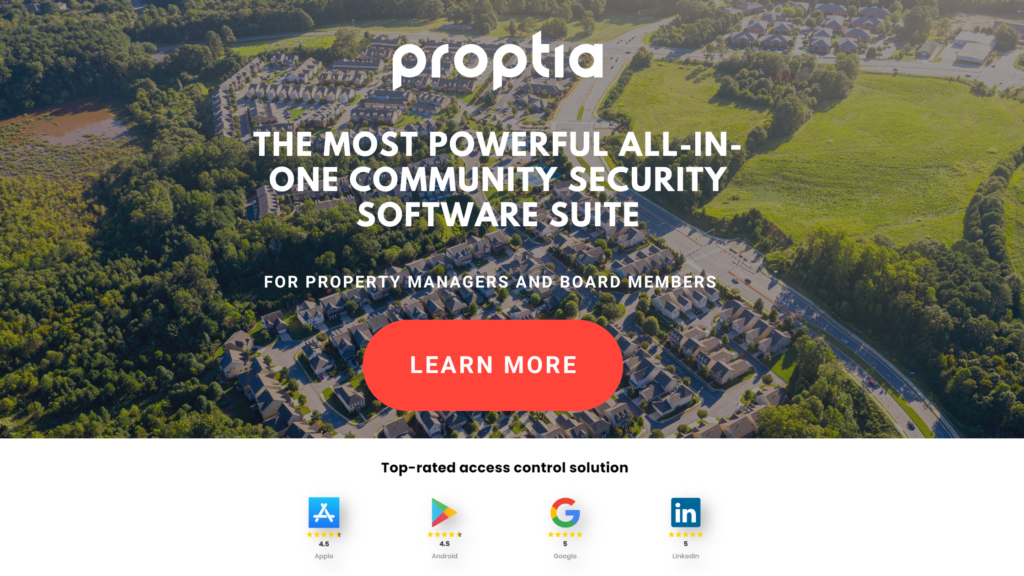All of us deserve to live in a community that prioritizes safety and peace of mind. The gates open only for those who belong, guests are welcomed with ease, and you can conveniently manage everything right from your phone. This is the reality for many homeowners associations (HOAs) that invest in effective access control systems.
Experienced community managers use strong access control procedures and technology to create a secure, comfortable environment for everyone. They can enhance the resident experience, keep property values high, and give everyone a sense of safety.
In this article, we dive into why access control is so crucial for HOAs and what features make a difference when choosing the right system.
- Why Access Control Matters for HOAs
- The Benefits of Modern Access Control Systems
- Must-Have Features in an Access Control System
- Looking Forward: AI and IoT in Access Control
- Conclusion
Why Access Control Matters for HOAs
While preventing unauthorized entry is a big part of access control, it’s not everything. It’s about creating a neighborhood where people feel protected and valued.
HOAs prioritizing access control shows residents they are committed to their safety and well-being, which translates to a happier, more cohesive community. After all, who wouldn’t want to live in a place that takes their safety seriously?
The Benefits of Modern Access Control Systems
A well-implemented access control system builds trust and confidence. Residents are more likely to engage, participate, and invest in a community where they feel secure.
The benefits don’t stop there—potential buyers are also drawn to communities with strong security measures, which can boost property values. If someone sees that a community is modern, organized, and secure, they’ll be much more interested in wanting to live there.
Let’s examine these benefits in detail.
1. Keeping Things Safe and Sound
Let’s start with the obvious: security.
An HOA’s first job is to keep residents safe, and access control systems are a crucial part of that. It’s not just about having a guard at the gate; today’s systems use advanced technology like mobile credentials and biometric scanning.
License Plate Recognition (LPR) systems are game-changers for communities with vehicle access points. They automatically scan and verify vehicles, making sure only those with permission can enter. It can make a significant impact, giving everyone peace of mind knowing that each car entering is accounted for.
2. Real-Time Monitoring: Staying One Step Ahead
Another great advantage of modern access control systems is real-time monitoring. Imagine your team getting an alert on your phone when someone tries to enter the community—whether it’s a resident, a guest, or an unrecognized vehicle.
This instant feedback allows property managers and security teams to respond quickly, ensuring that any issues are addressed before they escalate.
Connecting Surveillance Systems for Extra Eyes on the Ground
When access control systems are linked with surveillance cameras, it’s like having eyes everywhere. You can see who’s entering the community and what they’re up to, all from a single platform.
This integration makes monitoring seamless and efficient, which is crucial for catching anything suspicious before it becomes a problem.
3. Convenience for Residents and Their Guests
Access control systems shouldn’t just be about keeping people out; they should also make living more accessible for residents. No one wants to juggle multiple keys or fobs, especially when smartphones can handle everything.
Mobile credentials allow residents to access their homes with just a tap on their phones. This makes life easier and cuts down on the risk of lost or stolen keycards.
Making Visitor Management a Breeze
Who likes dealing with the hassle of getting guests in and out? Modern systems now allow residents to manage their guests digitally, pre-approving them and issuing temporary access passes right from their phones. Guests can enter the community smoothly without any hold-ups, and residents get notified as soon as their visitors arrive.
This kind of convenience is a game-changer and goes a long way in building a sense of trust and ease among neighbors.
4. Saving Money and Simplifying Operations
Who says access control has to be expensive? With the proper setup, HOAs can actually save money. Automated systems reduce the need for manual processes and can even cut down on the need for round-the-clock guards.
Hybrid models—where security personnel are present during peak hours, and automated kiosks handle quieter times—strike a perfect balance between cost and security.
The Power of Cloud-Based Solutions
Scalability is another benefit worth highlighting. As communities grow or adapt, cloud-based access systems offer the flexibility to expand without significant investment or disruption.
Property managers can manage everything remotely, from updating permissions to monitoring new entry points. It’s all about making things easier, safer, and more efficient for both residents and HOA teams.
Must-Have Features in an Access Control System
When it comes to picking the right access control system, it’s essential to focus on features that deliver both security and flexibility. Here are the top ones every HOA should consider:
1. A Solid Visitor Management System
If you want to make sure only approved visitors are entering the community, a vital visitor management feature is a must. Residents should be able to issue temporary passes that log every guest’s activity, ensuring that the community remains secure and organized.
Combine visitor management with License Plate Recognition (LPR), and you have a seamless system where every vehicle and visitor is accounted for. This extra step boosts security and ensures the visitor process is as smooth as possible.
2. Scalability and Cloud Integration
Communities are constantly evolving, and access control systems need to keep up. Cloud-based solutions make adding new access points easy and allow you to adjust permissions as required. Plus, they centralize data, making managing everything from one platform easy.
3. Security-Enhanced Mobile Credentials
Today’s systems use non-cloneable mobile credentials and biometric recognition to keep access secure. These technologies are hard to duplicate and make it convenient for residents to manage their access.
4. Integration with Other Security Features
An access control system isn’t working at its best unless it’s connected to other security features like alarms and surveillance cameras. When these systems work together, they create a network that ensures quick response times and maximizes safety.
Looking Forward: AI and IoT in Access Control
What’s next for access control in HOAs? The future lies in harnessing the power of Artificial Intelligence (AI) and the Internet of Things (IoT).
These advanced technologies can transform how security is managed, making systems smarter, faster, and more responsive.
AI: Predictive and Proactive Security
AI’s role in access control goes beyond simple monitoring. It introduces predictive and proactive elements that enhance community security. By analyzing entry and exit patterns, AI can identify anomalies in real-time—like someone attempting to enter repeatedly at unusual hours or multiple unauthorized attempts at various entry points.
AI-powered systems can then alert property managers immediately, allowing them to take action before a potential security breach occurs. This predictive capability minimizes risks by identifying threats before they escalate, ensuring residents remain safe and secure.
IoT: A Seamless, Connected Network
While AI provides the brainpower, IoT connects everything together, creating a fully integrated and responsive security network. IoT-enabled devices, such as smart cameras, sensors, and digital locks, communicate seamlessly with access control systems.
A network allows for real-time data sharing across devices, so if one sensor detects movement, nearby cameras can focus on that area, providing a comprehensive view of any activity.
This interconnected approach also makes it possible to control and monitor access points remotely. For example, property managers can use mobile apps to lock or unlock gates, issue temporary access passes, or check camera feeds—all from their phones, no matter where they are.
AI and IoT Working Together: The Future of Smart Access Control
When AI and IoT are combined, they create a powerful, dynamic system that’s capable of evolving with the community’s needs.
For instance, AI can analyze data from various IoT devices—like the frequency of entries at different times, visitor behavior, or even environmental conditions (e.g., lighting levels or weather patterns)—to refine access protocols.
Automation and Flexibility
Automation lets property managers control access remotely and set time-based permissions, like allowing maintenance staff entry only during certain hours. As technology advances, these features will continue to grow, making HOA communities safer and more convenient than ever.
Conclusion
Access control is more than just securing the gates; it enhances the community experience. Modern systems provide the perfect blend of security, convenience, and value, creating a welcoming and safe environment for all residents.
Whether it’s managing visitors, integrating AI, or simplifying operations through the cloud, access control systems are the backbone of a thriving, harmonious community.
Ready to take your community’s security to the next level? Check out Proptia’s advanced access control solutions, where security operations from visitor management to guarding solutions can be integrated and streamlined via a single cloud-based platform.


